Research & Teaching
Examining Perspectives of Teaching Among Biology Teaching Assistants
Journal of College Science Teaching—January/February 2022 (Volume 51, Issue 3)
By Joshua W. Reid and Emily G. Weigel
Recent reform efforts in postsecondary science teaching have called for shifts in instructional methods to include more evidence-based instructional practices. However, a myriad of factors play a role in whether an instructor adopts these more student-centered methods. One such factor is teaching perspective. In this study, we explored the teaching perspectives of both graduate and undergraduate teaching assistants (TAs), as well as shifts in their perspectives after participation in an active-learning professional development course. Findings from this study suggest that while undergraduate TAs hold more nurturing perspectives of teaching, graduate TAs hold more apprenticeship perspectives; both groups, however, can experience perspective change through professional development and teaching experience. These findings have implications for professional developers and those who work closely with TAs.
In their frequently cited meta-analysis, Freeman and colleagues (2014) found that the use of active-learning, student-centered modes of instruction significantly increased student performance in undergraduate STEM classrooms. Indeed, undergraduate STEM education has begun to shift from models of instruction where students passively absorb knowledge to models of instruction where students construct knowledge through active participation (Brewer & Smith, 2011; Laursen, 2019). To apply these instructional techniques effectively, those who teach undergraduates need to be properly trained to support implementation of evidence-based practices.
Teaching assistants (TAs) play pivotal roles within undergraduate STEM instructional teams and often teach in introductory-level science courses (Connolly et al., 2016; Gardner & Jones, 2011; Sundberg et al., 2005). Indications of evidence-based instructional practices (EBIPs; i.e., active learning) relating to positive student achievement and outcomes (e.g., Freeman et al., 2014) suggest that TAs need to be trained to use EBIPs. Research suggests links between undergraduate student outcomes and the use of TAs, TA pedagogical preparation, and teacher cognition (i.e., beliefs about teaching and learning, perspectives of teaching; Reeves et al., 2016; Wheeler et al., 2017). Teacher cognition refers to factors that can influence whether an instructor teaches in a student-centered fashion, such as that promoted through active learning (Gardner & Jones, 2011; Reeves et al., 2016). Perspectives of teaching (i.e., an aspect of teacher cognition; Reeves et al., 2016) shape teaching practices through the interrelation of beliefs about teaching and learning and actions resulting from these beliefs.
TAs generally have had a variety of classroom experiences prior to teaching, which is why professional development related to pedagogy is needed to ensure TAs are prepared to teach (e.g., Gardner & Jones, 2011; Kember, 1997; Pratt et al., 2001; Shulman, 1986). While TA professional development programs have increased over the past 2 decades (Rushin et al., 1997; Schussler et al., 2015), the types of programs across institutions are highly variable (Schussler et al., 2015). The most common form of professional development is a pre-semester orientation or workshop that occurs at one point in time (Schussler et al., 2015). Research suggests, however, that effective professional learning is fostered through professional development programs that are longitudinal and learning-oriented and that promote active and collaborative learning (Desimone & Garet, 2015). As experiencing active learning has been shown to influence TAs’ propensity to teach actively (Desimone & Garet, 2015; Patrick, 2019), we posit that one mechanism to encourage active instruction is by shifting teaching perspectives of TAs. In this study, we compared the teaching perspectives of TAs before and after they participated in a professional development program.
Changing TA cognition through active-learning professional development
Reeves and colleagues (2016) proposed a theoretical model for assessing TA professional development (PD) programs. This model proposes three areas for assessment: (1) TA cognition, (2) TA practices, and (3) student outcomes. TA cognition refers to the beliefs, attitudes, and perspectives about teaching and learning that TAs bring into the classroom when they teach. All instructors, including TAs, bring to the classroom a variety of beliefs and perspectives about content, teaching, and learning (Kember, 1997; Pratt et al., 2001; Shulman, 1986). Research has demonstrated how these cognitive constructs can shape instructional practices (Addy & Blanchard, 2010; Bond-Robinson & Rodriques, 2006; Volkmann & Zgagacz, 2004). TA practices refer to the instructional decisions and practices that TAs use in their teaching. Kember (1997) and Pratt & Collins (2000) argued that these practices are shaped by preconceived notions about teaching and learning. Finally, student outcomes provide variables to evaluate the effect of TA cognition and practices on students. These outcomes can include achievement, persistence, retention, and interest, among others. These outcomes are shaped by the TA practices, which are shaped by TA cognition. Therefore, exploring TA cognition is of relevance for understanding the efficacy of professional development.
One component of TA cognition that has been understudied in the context of teaching assistants is teaching perspectives. Teaching perspectives are the beliefs and intentions held by instructors that guide actions related to teaching and learning (Pratt et al., 2001). In other words, a teaching perspective is a “lens through which we view teaching and learning” (Pratt, 2002, p. 6). Five teaching perspectives have been identified in the literature: transmission, apprenticeship, nurturing, development, and social reform (see Table 1 for more details; Pratt & Collins, 2000). Kember (1997) aligned these perspectives on a continuum from teacher-centered instruction (transmission) to student-centered instruction (apprenticeship, nurturing, developmental, social reform). Each perspective includes a combination of beliefs, intentions, and actions about how students learn, how learning occurs, and what learning looks like (Pratt, 2002; Pratt et al., 2001; Pratt & Collins, 2000).
While Pratt (2002) cautioned against using teaching perspectives as synonymous with teaching methods, he does suggest that there is a relationship between behaviors in implementing teaching and learning activities. For instance, while both transmission and nurturing perspectives might lead to question-and-answer teaching methods, how questions are asked and how teachers listen to students might differ based on these perspectives. Therefore, it is important for instructors to reflect on their teaching perspectives.
Research questions and hypotheses
Scholarship points to apprenticeship and nurturing as dominant teaching perspectives for higher education faculty, adult teachers, and graduate students (Pratt & Collins, 2000). However, little research has been conducted on TA perspectives of teaching. Pratt (2002) included graduate student TAs as well as those not teaching; we focused this study by examining teaching assistants only. Despite the educational-level differences between undergraduate and graduate students, research has demonstrated that undergraduate teaching assistants (UTAs) and graduate teaching assistants (GTAs) are more similar than different (Chapin et al., 2014; Otero et al., 2006; Wheeler et al., 2017). Therefore, we hypothesized that given the previous research asserting other similarities between UTAs and GTAs, these groups would also have similar teaching perspectives. Additionally, we predicted that by engaging in a professional development course, TAs would shift their teaching perspectives from teacher-centered (i.e., transmission) to more student-centered (i.e., apprenticeship, nurturing, development, social reform; Pratt et al., 2001), as the PD course provides opportunities to develop more nuanced understandings of teaching and reflect on one’s current beliefs and actions related to teaching. However, we expect that some characteristics, such as the TA’s gender or the class type to which they are assigned (lecture vs. laboratory), may modulate these effects. The present study tested these hypotheses by measuring TAs’ teaching perspectives both before and after participation in a PD course focused on EBIPs. To test these hypotheses, we asked the following questions:
- How do the baseline perspectives of teaching among UTAs and GTAs differ from other instructor and student populations?
- Are there differences among TAs in their teaching perspectives?
- Do TAs shift their perspectives on teaching after participating in an active-learning TA PD course?
Study context: Professional development description
TAs enrolled in a PD course concurrent with their first teaching experiences. The course was team-taught using active-learning practices (i.e., think-pair-share, jigsaw, role play, case studies, etc.) and focused on procedural expectations, general institute policies (e.g., Family Educational Rights and Privacy Act regulations), and EBIPs (e.g., Freeman et al., 2014; Handelsman et al., 2007). The curriculum and instructor remained constant across semesters to minimize instructional differences between semesters.
Each week, TAs could pose a question or highlight an issue they encountered in their teaching in the past week. The instructors and the fellow TAs would work together to find a solution that fit both institute policy and the TA’s approach to teaching. An active lesson on tested elements of scientific teaching followed (e.g., Bloom’s taxonomy and learning objectives, inquiry instruction, case studies, and group work, among others). Students worked regularly in small groups (three or four people) for activities in the course, and attendance in the course was mandatory for all sessions. This course model was therefore closely based on the learning theories of constructivism (von Glasersfeld, 1998) and cooperative learning (Johnson et al., 2000). This model capitalized on both the ability of fellow TAs to guide learning in the room and on the interaction with and conceptual organization of material (Taylor et al., 2000). This model in turn provided opportunities for TAs to deliberately think about and reflect on their perspectives of teaching while being exposed to effective teaching strategies (e.g., Mezirow, 2003).
In addition to in-class work, TAs were expected to complete pre-class readings and discussion forum prompts, as well as weekly blog reflections on the materials covered after class. Twice during the semester, TAs designed and taught a mini lesson (3 to 5 minutes) of their choice individually and received feedback (both on content and practices) in small groups consisting of four fellow TAs and an instructor. At the end of the course, each TA completed a learning portfolio, which was a collection of items from class activities and writing throughout the semester that showcased what each TA learned in this course. The portfolios included at least eight writing samples from a combination of forum responses and blog posts, lesson plans from their teaching experiences, and a summative 1-page reflective essay explaining the significance of items chosen to exemplify their learning and growth as a teacher.
Methods
Our study was conducted across two semesters, spring 2017 and fall 2017, at a large southeastern research-intensive university (as defined by Carnegie Classification of Institutions of Higher Education, n.d.). At the beginning and end of the course, we administered the Teaching Perspectives Inventory (TPI) to examine TA teaching perspectives as they began and left the program, as well as how their perspectives changed with respect to demographic factors (e.g., gender, type of course, and TA’s graduate or undergraduate status) and controlling for semester. We provided class time for students to complete the survey, ensuring a 100% response rate.
Study participants
Participants included graduate and undergraduate students currently serving as TAs, 38 (of 39) from spring 2017 and 10 (of 12) from fall 2017, all of whom consented and had no prior teaching experience (total N = 48). Graduate students included students pursuing a master’s or doctoral degree in biology or bioinformatics, and undergraduates included biology and biochemistry majors.
To pool the data across semesters, we tested for population differences between semesters using a chi-square test for independence for categorical data (gender, type of course, and graduate or undergraduate status of the TA) and found no significant differences despite large size differences in the TA groups (all p > .05). While we provided multiple gender options (e.g., transgender male, non-binary, self-label box), students responded only with male and female. Additionally, there was little racial diversity, which made it necessary to omit race as an examined demographic variable. However, for robustness, we chose to incorporate semester as a factor in our models to detect whether underlying effects attributable to semester could not simply be reduced to demography.
Instrument
The TPI was developed to identify the dominant and recessive teaching perspectives held by instructors (Pratt & Collins, 2000). The instrument has a robust history of validity evidence with multiple populations, including graduate and undergraduate students (Collins & Pratt, 2011; Pratt & Collins, 2000), so it was suitable to use in this study. Undergraduate STEM instructors can hold multiple perspectives, but one or two typically take precedence (dominant perspectives) over others (recessive perspectives). The TPI measures commitment to a perspective in two ways. First, it measures commitment using a summation of Likert-type values (1 = never; 5 = always) from 45 survey items (9 items per perspective). The highest score possible for each perspective is therefore 45 and the lowest is 9. Higher scores on the TPI indicate a stronger commitment to a perspective. The second measurement for commitment to a perspective is ranking, which is based on whether an individual scored a perspective higher than other perspectives. In this case, lower ranking on the TPI indicates a stronger commitment to a perspective because a ranking of 1 refers to the dominant perspective. Overall, a high strength of commitment can be obtained by having a high score and low ranking.
Statistical analyses
Several different generalized linear mixed-effect models (GLMMs) were run in R (R Core Team, 2017) with the package lme4 (Bates et al., 2015) to examine the results of this study based on the questions asked and statistical agreement with model assumptions.
Results
Research Question 1:
We measured the teaching perspectives of graduate and undergraduate TAs prior to and following a professional development course paired with their first teaching experience (Figure 1). Figures 2 and 3 display the dominant teaching perspective for graduate and undergraduate TAs prior to and after instruction. In Figure 3, the bands connecting the two sides of the figure represent how individuals changed from pre- to post-course. For instance, in Figure 2, the majority of students who held no dominant perspective before the course shifted to holding apprenticeship as a dominant perspective after the course. Supplemental Tables 2 and 3 (which can be found at https://bit.ly/3nvdiGY) display the secondary dominant perspectives (i.e., the second-ranked perspective, when present) and the recessive perspective (least-chosen perspective), respectively.
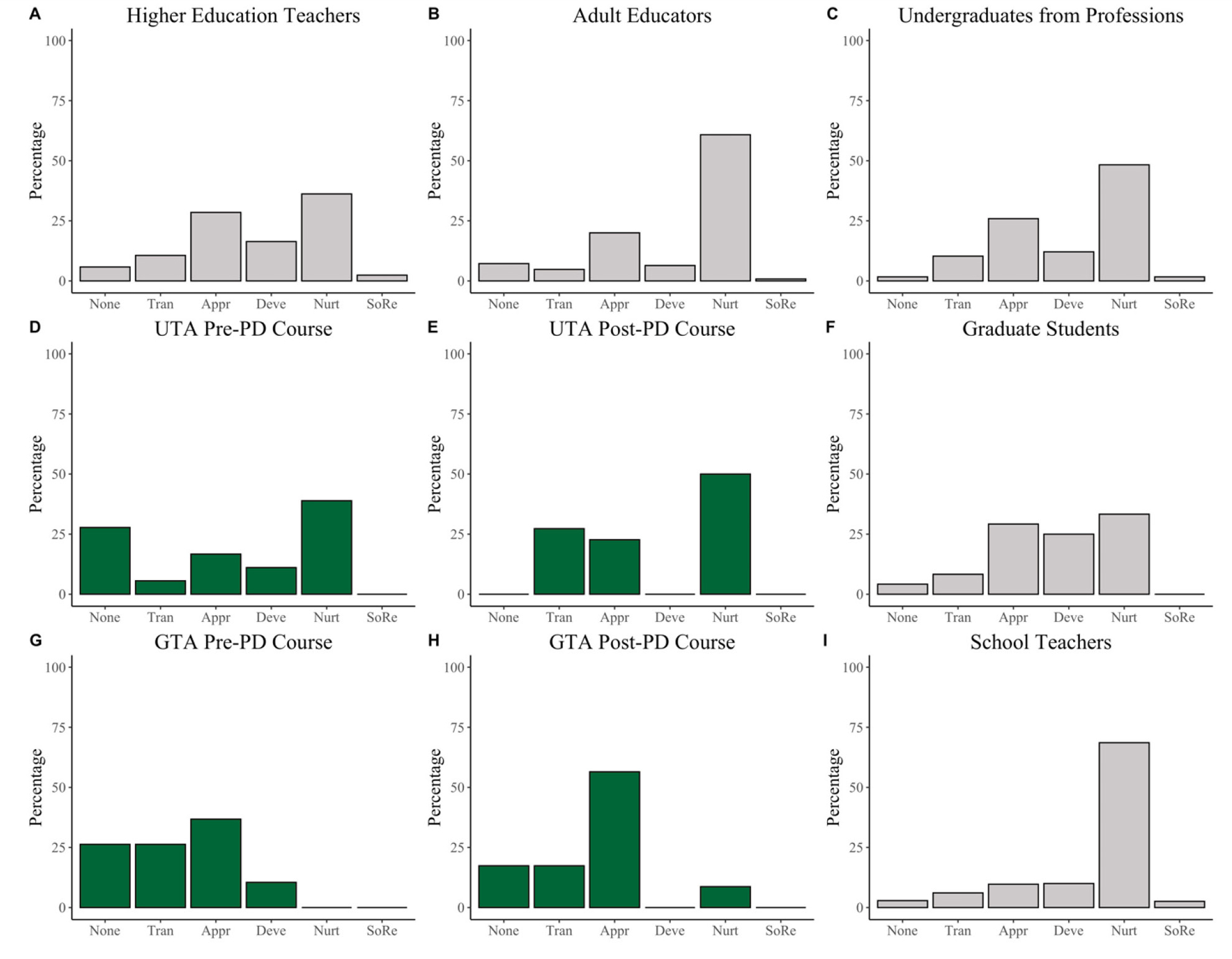
Dominant teaching perspectives by occupational category.
Note. Green bar graphs represent data collected in this study while gray bar graphs represent comparison data collected in Pratt et al. (2001). None = no dominant perspective, Tran = transmission, Appr = apprenticeship, Deve = developmental, Nurt = nurture, SoRe = social reform, UTA = undergraduate teaching assistants, GTA = graduate teaching assistants, PD = professional development.
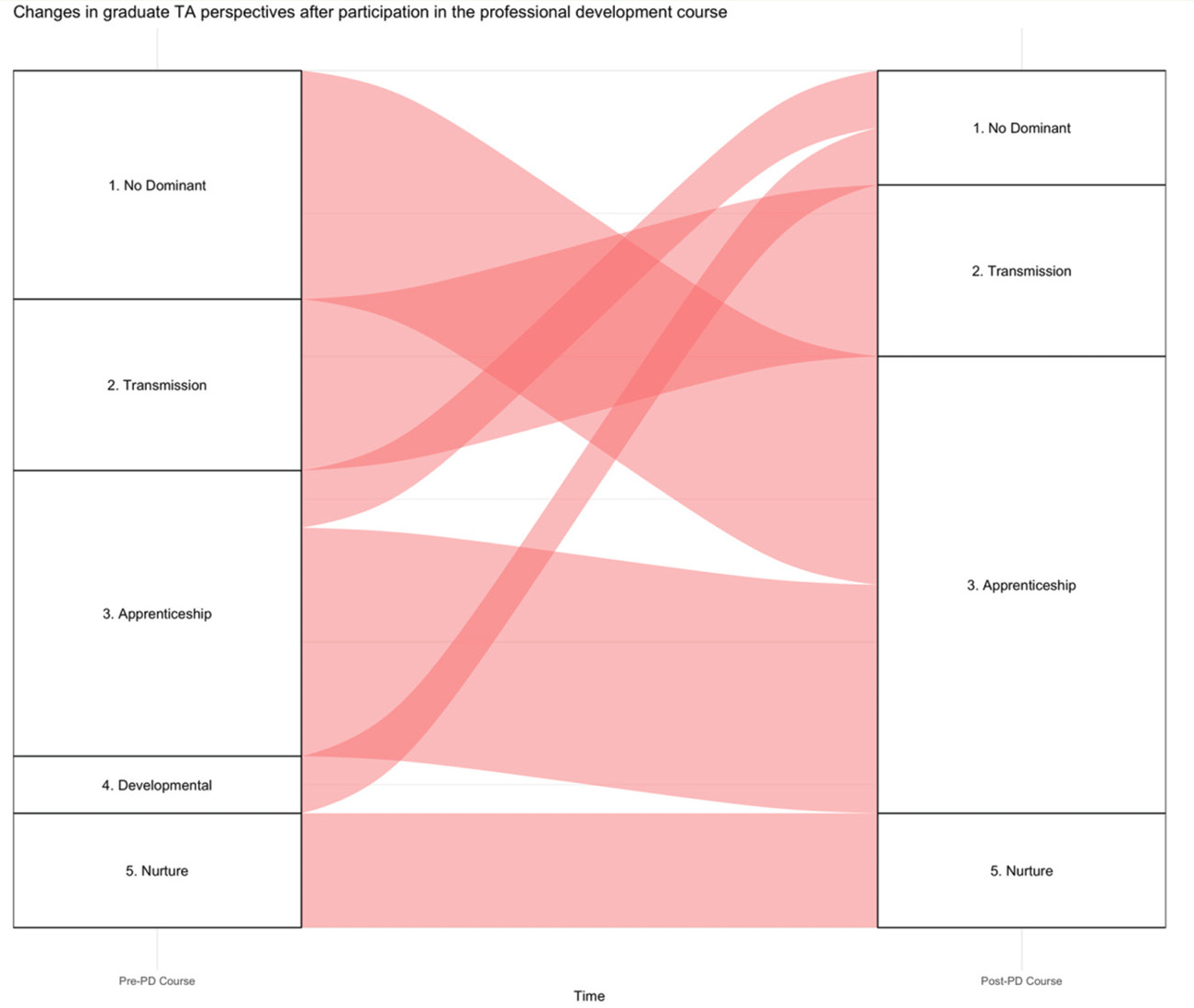
Changes in graduate TA perspectives after participation in the professional development course.
Note. Bands in the center of the figure show changes in dominant perspectives. Thicker lines represent more participants than smaller lines.
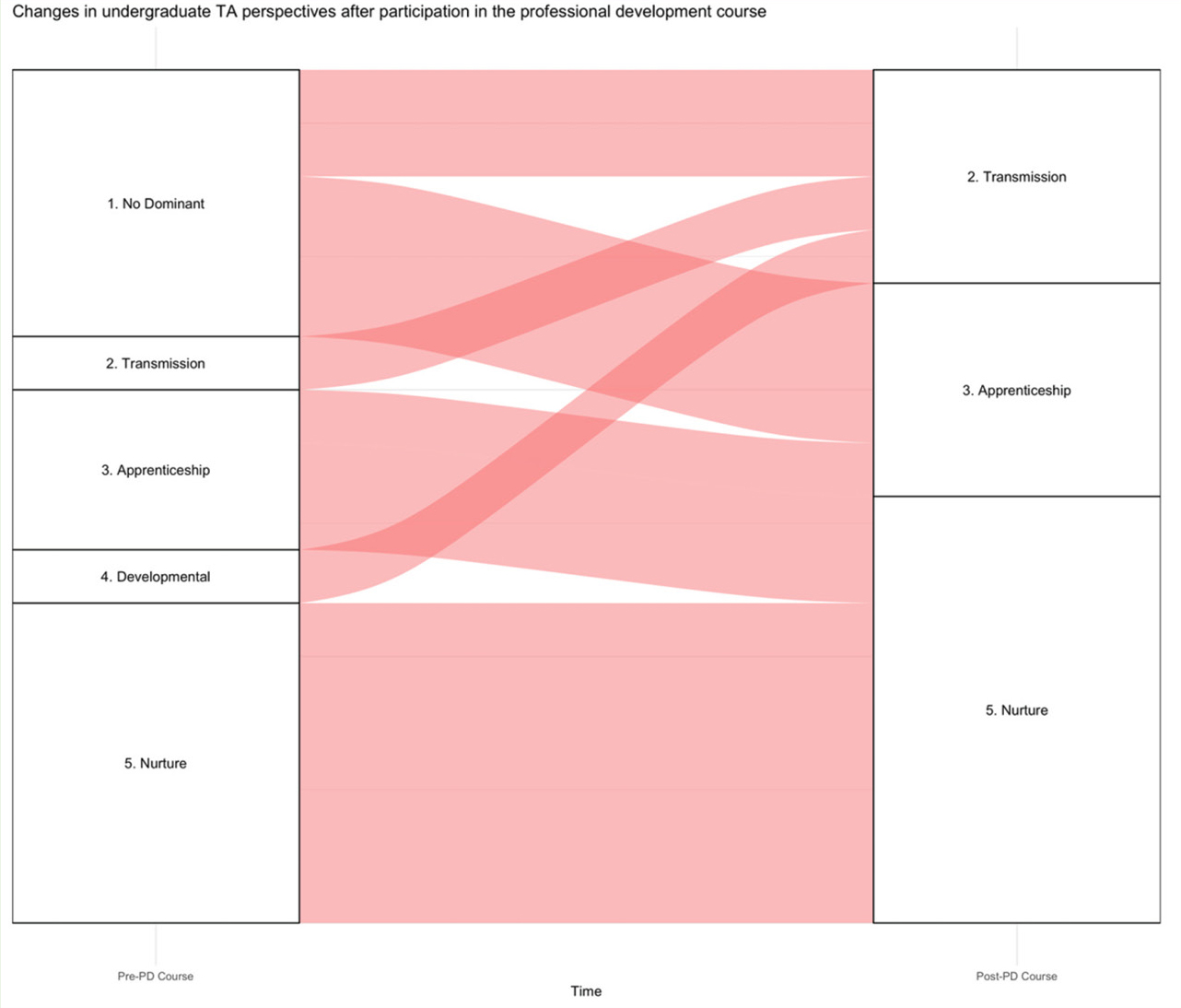
Changes in undergraduate TA perspectives after participation in the professional development (PD) course.
Note. Bands in the center of the figure show changes in dominant perspectives. Thicker lines represent more participants than smaller lines.
To compare UTAs and GTAs statistically, we first considered how strongly our respondents scored each perspective; considering this allows us to determine whether differences exist simply because one group gives higher numeric responses, on average, compared to other groups. Overall, the “strength” of the mean TPI score (how strongly the respondents ranked, on average, for all perspectives), as well as the standard deviation among TPI scores, was not statistically significantly different between UTA and GTA groups (GLMM, p > .05 in all cases). Similarly, when considering the scores given to the highest (dominant) and lowest (recessive) teaching perspectives, neither the overall score for the dominant nor the recessive teaching perspective was statistically significantly higher or lower (GLMM, p > .05 in all cases), eliminating the possibility of strong outliers skewing the data. When considering the range of scores across perspectives and relative difference between the dominant and secondary perspectives, the scores were not significantly different between TA groups; similarly, the range of scores separating each perspective and the frequency of dualities among the perspectives were statistically equivalent across demographic groups (GLMM, p > .05 in all cases). These results held at both timepoints (pre-PD and post-PD course). Thus, respondent scores are not reflective of outliers or stronger responses within groups; rather, they represent real differences in UTA vs GTA teaching perspectives.
In our data set, nurturing was the dominant perspective for undergraduates both before and after instruction, and apprenticeship was the dominant perspective for graduate students (GLMM, t = 2.173, p = .038). This was in contrast to prior data with higher education teachers, adult educators, undergraduates, graduate students, and school teachers, where nurturing was ranked higher (Pratt & Collins, 2000). Additionally, social reform was not ranked as a dominant or secondary dominant perspective for our sample, whereas it appeared in other populations (Pratt & Collins, 2000).
Research Question 2:
Graduate students and male students specifically ranked nurturing on average higher than their undergraduate and female counterparts (GLMM; Status: t = -2.144, p = .04; Gender: t = -2.793, p = .009; Figure 4). Additionally, it is clear that undergraduates harbored many dualities in the dominant category prior to instruction (see Supplemental Table 1 at https://bit.ly/3nvdiGY). This effect was largely driven by undergraduate males (GLMM; t = 2.207, p = .035) and disappeared post-instruction (GLMM, p > 0.05). The absolute rankings of social reform and developmental perspectives for all rankings were also found to be statistically independent of any specific TA demographic groups (i.e., status, gender, type of course; GLMM, p > .05).

Boxplot comparison of nurturing perspectives between male (M) and female (F) TAs.
Note. Pre-instruction graphed here. Male TAs rate nurturing significantly higher among teaching perspectives compared to female TAs pre- and post-instruction.
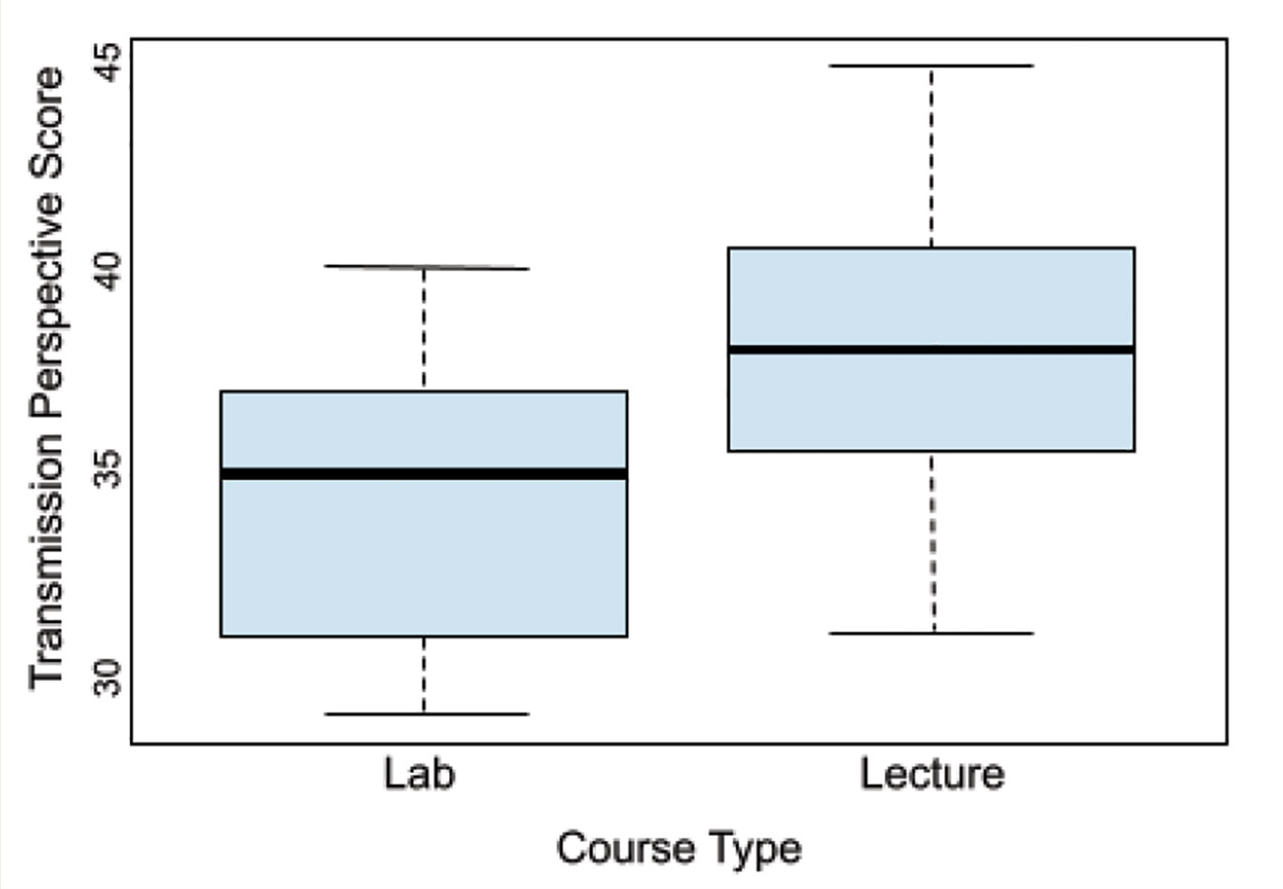
Boxplot comparison of laboratory and lecture TAs transmission perspectives.
Note. Pre-instruction graphed here. Lab TAs scored the teaching perspective transmission significantly lower compared to lecture TAs prior to instruction.
Somewhat unexpected, we found that even prior to instruction, TAs scored transmission higher simply depending on the course to which they were blindly assigned; namely, if assigned to a lecture-based course, those TAs scored transmission higher as a perspective (GLMM; t = 2.551, p = .016; Figure 5). This indicates that TAs who teach in lecture-based courses generally hold transmission perspectives compared to their counterparts who teach laboratory-based courses. As a general trend, transmission was ranked lower by males compared to females prior to instruction, regardless of course (GLMM; t = 2.248, p = .032; Figure 6). This suggests that females generally hold stronger transmission perspectives compared to males.
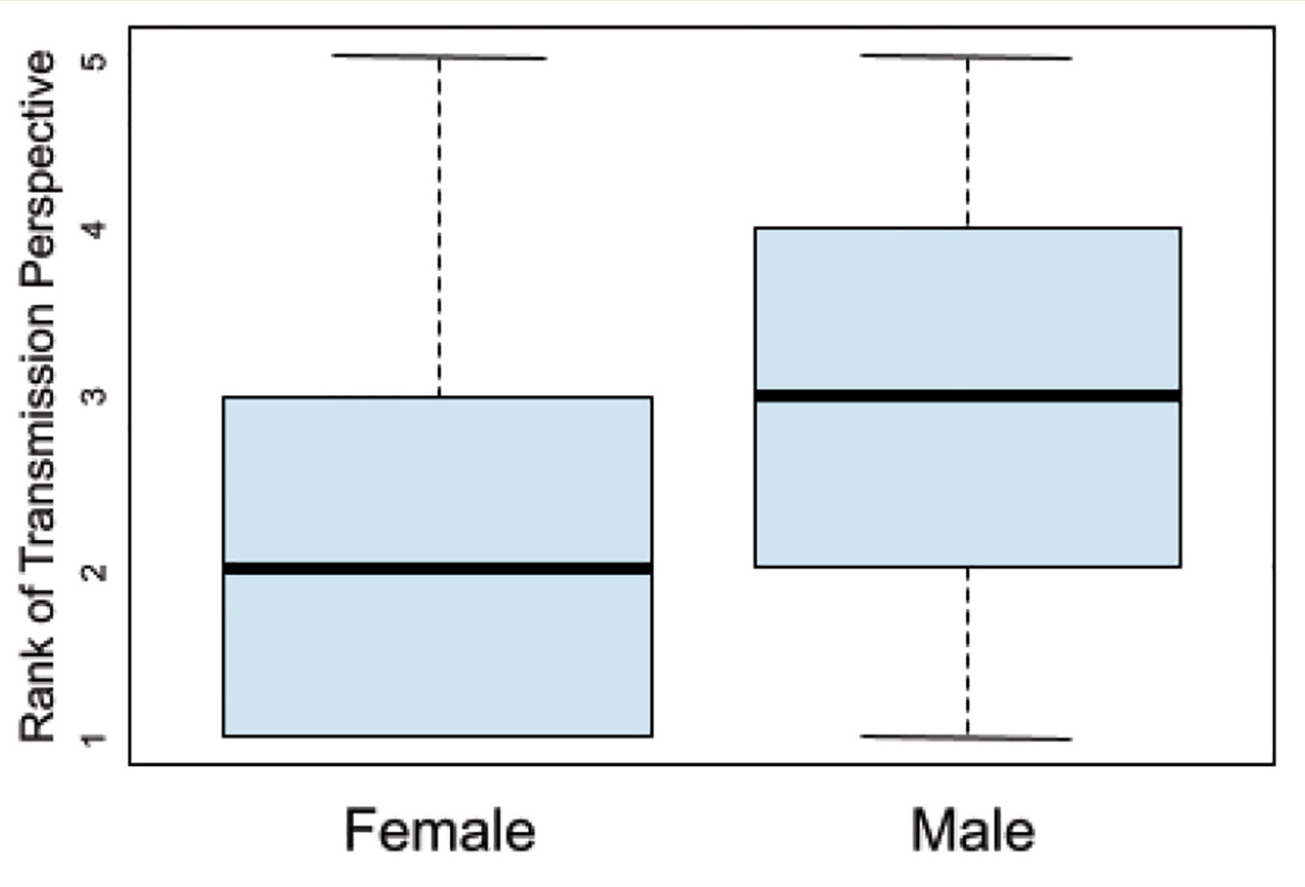
Boxplot comparison of transmission perspectives between male (M) and female (F) TAs.
Note. Pre-instruction graphed here. Male TAs rate transmission significantly lower among teaching perspectives compared to female TAs prior to instruction.
Research Question 3:
After instruction, we found that the relative ranking of developmental among the perspectives increased for males, undergraduates, and those teaching lab courses (GLMM; Gender: t = 2.953, p = .006; Status: t = 2.698, p = .011; Course Type: t = -2.304, p = .027). Similarly, the rank of social reform increased for males (GLMM; t = 2.166, p = .037). Overall, however, males appeared to change significantly less in the strength of their overall TPI scoring (GLMM; t = -2.347, p = .026), showing more swaps between adjacent rankings but less drastic ranking changes than their fellow female TAs. While other demographic categories were not found to show significant differences post-instruction, we did find that lecture TAs appeared to be much more difficult to shift in their perspectives, particularly in their consistent, high rating of the transmission category (GLMM; t = -3.308, p = .003). Overall, differences in TA perspectives post-instruction appeared to be driven by gender and course assignment rather than other factors.
Discussion and implications
This study highlights differences and shifts among TAs’ perspectives of teaching both before and after participation in a professional development course. GTAs, both pre- and post-instruction, were more likely to hold transmission and apprenticeship as dominant perspectives of teaching, rather than developmental, nurturing, and social reform perspectives compared to previously studied groups (Pratt et al., 2001). While it is important to note that each perspective is neither good nor bad, the majority of transmission or apprenticeship perspectives gives insight into how GTAs view knowledge and teaching. Additionally, we found evidence that these perspectives are influenced by gender and course assignment. For instance, lecture-based TAs appear to favor transmission views when compared to laboratory-based TAs, suggesting transmission views of teaching are associated with lecturing. One potential explanation may be that laboratory-based courses mimic research practices more closely than lecture-based courses, which could explain why apprenticeship perspectives of teaching were more salient in TAs that taught laboratory-based courses. This may be a reflection of their experiences with mentoring and apprenticing with their research advisers. However, this presents a polarized view of how TAs think about knowledge between lecture and laboratory-based courses, with lecture being more content-oriented. Future work should explore whether (more nuanced) differences in teaching perspectives are found among TAs who teach in more reform-oriented ways compared to those who teach more traditionally.
Reeves et al. (2016) argued that characteristics of GTAs influence their teacher cognition (i.e., teaching perspectives, attitudes, beliefs). Similarly, we found empirical evidence that gender (male vs. female) and course assignment (lecture-based course vs. laboratory-based course) were critical factors that drove differences in TA perspectives after participation in the professional development course. Additionally, while UTAs and GTAs are similar in many respects (i.e., training, teaching experience, content knowledge; Luft et al., 2004; Wheeler et al., 2017), we found evidence that they can differ in their teaching perspectives. Our results indicated that UTAs’ dominant perspective of teaching was nurturing, while GTAs’ dominant perspective was apprenticeship. One explanation could be that the teaching perspective is driven by relatability of the instructor status with the students. UTAs are more similar to undergraduate students than GTAs, so UTAs may structure their teaching to be more caring and focused on the students from an affective perspective. Research has found that students tend to find TAs (in general) more caring and nurturing than faculty (Kendall & Schussler, 2012), which could be extended to UTA-GTA differences. Alternatively, GTAs could be modeling apprenticeship perspectives of teaching after their research apprenticeships with their research peers and advisers. This finding suggests that similarities between students and the instructor may influence teaching perspectives. However, researchers should then ask why changes occur as an undergraduate transitions to graduate school (i.e., UTA to GTA).
The professional development course in this study offered opportunities for TAs to reflect on teaching perspective and engage in modeling of student-centered teaching. Patrick (2019) has discussed how participation in an active-learning-based professional development program can promote the use of evidence-based strategies by TAs in their courses. Our study revealed that a developmental perspective became more favored by males, UTAs, and laboratory-based instructors. This finding indicated that TAs considered the students in terms of their individual understandings and thought it was their role to guide the students and provide opportunities to help them develop rich understandings of the content.
As Pratt (2002) discussed, teaching perspectives are neither good nor bad but represent the beliefs and views that an individual holds toward teaching and learning. Our data suggest that secondary dominant perspectives may not be as marginal as other populations; therefore, pedagogical training should focus on solidifying perspectives to provide a foundation for reflection. Concurrently, reflection on perspectives could help with solidifying these perspectives. Professional developers should not focus on one primary perspective when designing professional development, but rather should create opportunities for participants to reflect on their own perspectives. We encourage professional developers to use the TPI as a way to provide a reflective opportunity in professional development programs. Additionally, professional development programs should consider the context in which TAs are working (i.e., laboratory-based or lecture-based courses). Future research will look at how teaching perspectives might be related to whether TAs identify as a teacher, to what extent, and how long the TA has been teaching. Acknowledging the variability in teaching perspectives and contexts in which TAs operate, scholars can more accurately describe the mechanisms by which TAs, and other undergraduate instructors, learn to teach.
Acknowledgments
We thank the TAs who participated in this research, as well as James Cawthorne for insight in the early stages of this project. Additionally, we thank the Gardner Research Lab at Middle Tennessee State University for feedback and review of this work.
Joshua W. Reid (Joshua.reid@mtsu.edu) is a postdoctoral research fellow in the Tennessee STEM Education Center at Middle Tennessee State University in Murfreesboro, Tennessee, and Emily G. Weigel is a senior academic professional in the School of Biological Sciences at the Georgia Institute of Technology in Atlanta, Georgia.
Biology New Science Teachers Preservice Science Education Teaching Strategies


